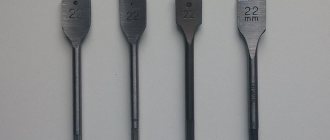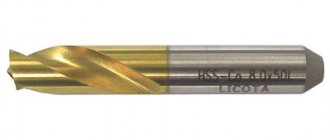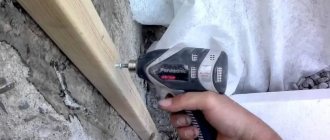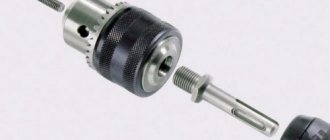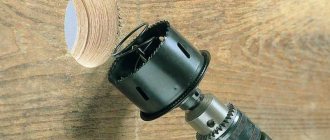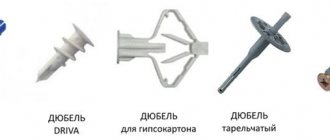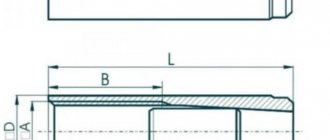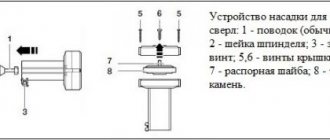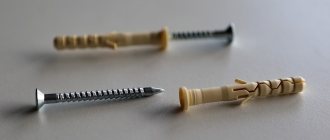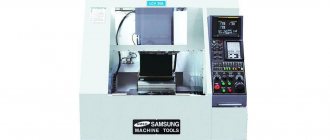Drilling is one of the most commonly used methods for processing various parts and structures. The materials in which holes are made can have different structures, both more dense and less solid. The channels are drilled using a drill. For soft surfaces, such as wood, tools made of high-speed steel are used. Metal can also be processed with such equipment. But concrete, brick and similar building materials can only be overcome by a Victory drill.
The structure of concrete structures is such that it contains natural abrasive components, therefore, when exposed to it with an ordinary steel tool, the latter will become unusable. A drill tipped with Pobedit, which has a super-hard surface and is low in abrasion, can effectively drill through such materials without requiring frequent sharpening.
Pobedite equipment must be used exactly for its intended purpose. Concrete drills are not suitable for drilling steel and wood!
Design features of the drill with pobedit
A standard tool with a pobedite tip consists of the following structural elements:
- Shank is a cylindrical, multifaceted or cone-shaped (Morse cone) part of the drill, with which it is secured in special equipment.
- Working part with spiral grooves - this structural element serves to remove concrete dust and crumbs from the area of the formed channel. There are no cutting edges like conventional equipment.
- Carbide plate or pobedite head. This structural element is directly involved in drilling. It has a tapered front part where the front cutting edges are located, and side cutting edges for channel calibration. Sometimes the working head is not made from a solid plate, but is limited to pobedit soldering.
VIEW Drills on AliExpress → Separately, it is worth mentioning the design of a Pobedit drill for a rotary hammer. The special feature here is the original shank configuration. Unlike the usual one, which is clamped rigidly in the chuck, this element of the drill has the ability to perform oscillatory movements in the translational direction and is rigidly fixed in the direction of rotation of the axis. For this purpose, there are two guide grooves in the shank, one of which additionally serves as a quick-release fixation of the drill in the chuck. For better performance, a lubricant must be applied to the shank of this design.
Types of drills
Drills that are considered high strength or pobedite can be divided into two main categories:
- For electric drill. This tool can be used in tandem with a conventional or impact drill. They are designed for making holes in ceramic tile, plaster, brick and cinder block. Their feature is a shank adapted to be rigidly held in the chuck. This type of equipment is suitable for delicate drilling.
- Impact drills for rotary hammers, or, in other words, drills. They are distinguished from ordinary ones by the shape of the shank, which, without having a rigid attachment in the chuck, allows the tool to perform oscillatory movements. It is impossible to obtain high geometric accuracy of the channel with a pobedite drill, but, among other things, it can easily cope with concrete, reinforced concrete and stone.
Boers are also divided into three subgroups:
- Flat type drills. These are small Pobedit drills in length and diameter. Making holes with this tool requires more effort than other types of drills.
- Spiral type equipment. This tool can have different diameters, including large ones. The length here is not limited to short specimens.
- Auger type drills. These are super-long pobedit drills, allowing you to make channels over one meter. Due to the auger cut along the entire length, dust and concrete particles are easily removed from the channel.
The pobedit tips themselves come in different modifications: for drilling cast iron, aluminum, stainless steel or concrete.
How to drill concrete
To choose what to drill into a concrete wall, you need to follow the rules:
- Choose a tool with the ability to change the speed of the process, thanks to this the drill will work carefully without damaging the surface.
- Pay attention to whether the tool has impact drilling and depth adjustment; this gives good results when working with problem areas and helps soften them.
- Choose a drill that you can hold with both hands.
- Pay attention to the power of the tool.
Drilling with a hammer drill
The hammer drill is the most powerful tool, suitable for large volumes of work and for drilling concrete walls.
There are 2 ways this tool works: rotation and impact. For rotation, a special type of drill bit for a concrete hammer drill is used - a drill, it comes with a Pobedit drill bit. You can tell what a concrete drill looks like by its special shank, to which a special chuck is installed.
Such drills mean:
- SDS plus - has a thin shank and recesses to hold the hammer drill in your hand, the profile is symmetrical, it is easy to install this type of drill;
- SDS max - has a thick and long shank; correct installation is possible only in one position.
The pobedit tip is resistant to heavy loads. When the hole is located on the edge of the structure, drilling concrete using the impact method is not recommended, because A concrete structure may chip, and when working with ceramic tiles, the material will simply crack.
In this case, it is better to use a diamond concrete drill for a hammer drill; it has greater hardness than a Pobedit drill; you must take breaks during work to cool it; drilling at high speeds is prohibited.
Do not use hammer drilling with a diamond drill, as... Although it has great hardness, it is highly brittle and can crack.
Drilling
For small-scale work, especially in an apartment with thin walls, you can make a hole with a drill designed for drills for working with concrete. It can be either a win or a diamond product. A drill with a cylindrical shank is used for impact drills. When working, it is recommended to choose medium speed. Which drill bits for concrete are best to choose depends on the type of drill.
Advantages of pobedit drills
An analysis of the advantages of drills whose tips are equipped with pobedit material can be reduced to a consideration of the positive aspects of pobedit itself. This alloy was developed back in 1929 and consists of cobalt and tungsten, the percentage of which in alloy 10 is 90%, respectively. Why drills with pobedit tips effectively cope with materials such as brick, cinder block, concrete, its derivatives explain:
- The alloy has high strength. This means that it is very difficult to deform with conventional abrasive materials, and since concrete contains abrasive particles, the drill is not dull by it.
- If steel is a more viscous material and is removed layer by layer, then building materials are brittle and crumble. The drill is specifically designed for crumbling concrete, and not for cutting.
- Pobedit can withstand impact loads well without deformation of its cutting edges. This is relevant because all rotary hammers operate on the impact principle. Steel drills become deformed after an impact and are unable to work effectively.
- Some alloys can easily cut through steel - they are indispensable when drilling reinforced concrete with a frame made of reinforcement.
- The technology for producing modern pobedite alloys is characterized by low cost.
VIEW Drills on AliExpress →
Application area
Pobedite drills were developed primarily for installation purposes, to drill holes in various types of building structures, where traditional tools are powerless. The equipment can be used in the following operations:
- Drilling channels for laying electronic and electrical communications.
- Drilling holes for installing anchors and other structural fasteners.
- Obtaining channels for laying connecting elements of walls during the construction of building frames.
- Dismantling concrete structures, obtaining window and door openings, large openings for laying supply and exhaust ventilation, sewerage and water supply.
- Installation of fasteners for installing furniture, equipment and fittings.
- Drilling in fragile materials such as ceramic tiles, glass or earthenware.
- Drilling hard rocks.
- Drilling of hard alloys.
VIEW Drills on AliExpress →
One of the conditions for effective operation of a rotary hammer is that you do not need to apply excessive force when pressing on the pobedit drill. The equipment must have freedom of oscillatory movements, due to which the channel is made in the concrete.
Drilling recommendations
The drill should not be allowed to overheat; work should be interrupted every 16 seconds; the tool should cool naturally, without any liquid.
If stones hit during operation, it is difficult for this element to move further; the stone must be broken using a chipper, then work continues. When drilling a hole in a load-bearing wall or ceiling, it is recommended to use a hammer drill; with its help, the work can be completed as quickly and efficiently as possible.
It is also better to drill a reinforced concrete wall with a hammer drill. For a hole in ceramics on the wall, you cannot use the impact method or use a drill on concrete, otherwise the tile will collapse.
Cheap models can be sharpened from time to time using an angle grinder with a diamond blade mounted on it.
Which manufacturers to pay attention to
Pobedit drills from a manufacturer such as DeWalt, Extreme SDS-Plus series, can be considered the market leaders. A special feature of such drills is that they have a serrated cutting edge. This configuration allows you to effectively cut not only concrete, but also the reinforcement inside. The pobedite soldering is fixed here with copper solder, which allows the drill to be more resistant to overheating.
Another high-quality product among Pobedit drills can be considered a tool from Bosh. Peculiarities:
- High strength under bending loads.
- Using an original U-shaped groove that allows waste to be quickly removed from the channel.
- Using high-precision and durable pobedite carbide inserts.
Dear site visitors, support the topic in the comments - share your experience of using Pobedit drills.
What does it mean to win?
Engineers have been developing especially hard metal alloys for the manufacture of cutting tools since the beginning of the development of mechanical processing of metal on an industrial scale. And by the twenties of the last century, foreign and domestic scientists were able to find the optimal alloy composition that would satisfy the stated needs. This alloy was named Pobedit. Pobedit is a name given to a whole range of metal alloys with increased hardness, strength and wear resistance.
According to the Rockwell method, hardness indicators should reach 85-90 units.
The main material in Pobedite is tungsten carbide. Its content is within 90%. The remaining important components are cobalt and a limited amount of carbon. In some cases, expensive tungsten has recently been replaced with titanium, but if replaced, the alloy slightly deteriorates its important characteristics. Cobalt can also sometimes be replaced with nickel. Pobedit is a heat-resistant material. Its melting point is 3150 ˚С. It begins to lose its properties and become soft only at 1200˚C. They are obtained mainly by powder metallurgy methods.
Various solderings
Pobedit includes such grades of hard alloys as VK4, VK10, T15K6, V8, V6 and many other new alloys.
The disadvantages of this material include high fragility and low impact resistance, as well as relatively high cost. Therefore, metal-cutting tools are not made entirely of pobedit, but only some parts of drills are made from it or sprayed onto the surface. A pobedit drill has a cutting edge made of pobedit, and therefore has high strength and hardness.
